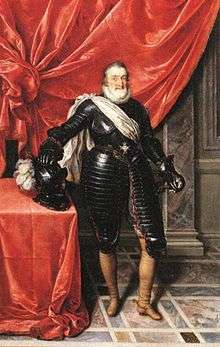Siege of Paris (1590)
| Siege of Paris | |||||||
|---|---|---|---|---|---|---|---|
| Part of the French Wars of Religion | |||||||
 Coat of arms of the city of Paris. | |||||||
| |||||||
| Belligerents | |||||||
|
|
| ||||||
| Commanders and leaders | |||||||
|
|
Duke of Nemours | ||||||
| Strength | |||||||
| 12,000 rising to 25,000 | Approx: 30,000–50,000 | ||||||
| ||||||
The Siege of Paris took place in 1590 during the French Wars of Religion when the French Royal Army under Henry of Navarre, and supported by the Huguenots, failed to capture the city of Paris from the Catholic League, and was finally successfully relieved by the Spanish army under the command of Don Alessandro Farnese, Duke of Parma.[1]
Background
After his decisive victory over the Catholic forces commanded by Charles, Duke of Mayenne and Charles of Guise, Duke of Aumale at the Battle of Ivry on 14 March 1590, Henry of Navarre advanced with his troops on his main objective of Paris, possession of which would allow him to confirm his contested claim to the French throne. Paris at the time was a large walled city of around 200,000–220,000 people.[2]
Siege of Paris
On 7 May, Henry's army surrounded the city, imposing a blockade and burning windmills to prevent a food supply from reaching Paris.[3] Henry had at this point only around 12,000–13,000 troops, facing an enemy of around 30,000–50,000. Owing to the limited amount of heavy siege artillery that Henry had brought, it was likely that Paris could only be compelled to surrender through starvation.[3] The city's defence was placed in the hands of the young Charles Emmanuel, Duke of Nemours.[3]
Henry set up his artillery on the hills of Montmartre, and bombarded the city from there. In July his force was swelled by reinforcements to 25,000 and by August he had overrun all the outlying suburbs of the city. Henry tried to negotiate the surrender of Paris, but his terms were rejected and the siege continued.
On 30 August, news reached the city that a Spanish-Catholic relief army under the general Don Alessandro Farnese, Duke of Parma (Spanish: Alejandro Farnesio), was on its way.[1] The Duke of Parma and his troops were able to send food supplies into the city, and after a final attack on the ramparts failed, Henry broke off his siege and retreated. An estimated 40,000–50,000 of the population died during the siege, most of starvation.[1]
Aftermath
After repeated failures to take the capital city of Paris, Henry IV converted to Catholicism, reportedly declaring that "Paris is well worth a Mass". The war-weary Parisians turned on the Catholic League's hardliners when they continued the conflict even after Henry had converted. Paris jubilantly welcomed the formerly Protestant Henry of Navarre in 1593, and he was crowned King of France. He later issued the Edict of Nantes in an attempt to end the religious strife that had torn the country apart.[4]
See also
- War of the Three Henrys
- Religion in France
- Edict of Nantes
- Anglo-Spanish War (1585–1604)
- List of French monarchs
- List of wars and disasters by death toll
Notes
References
- Horne, Alistair. Seven Ages of Paris: Portrait of a City. (2003) Pan Books.
- Holt, Mack P. (2005). The French Wars of Religion (1562–1629). Cambridge. ISBN 0-521-83872-X.
- Knecht, Robert J. (1996). The French Wars of Religion (1559–1598). Seminar Studies in History (2nd ed.). New York: Longman. ISBN 0-582-28533-X.
Coordinates: 48°51′24″N 2°21′06″E / 48.8566°N 2.3518°E
